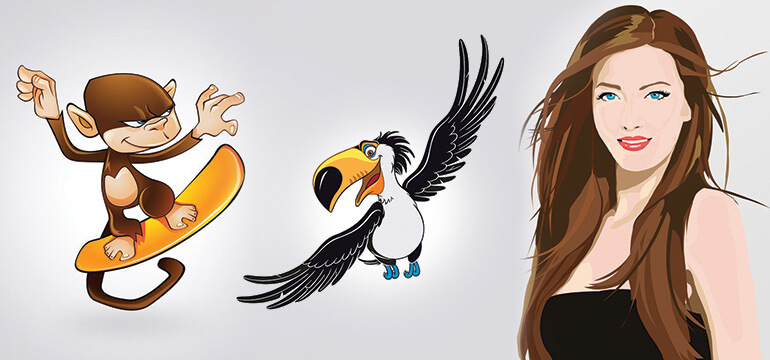Illustration plays a crucial role in graphic design, and the way we colour illustrations can significantly impact the final result. Whether you're a seasoned professional or just starting out, mastering colouring techniques is essential for producing high-quality work that stands out. Today, we will explore five amazing techniques for colouring illustrations, commonly used by top-tier professionals to enhance their designs.

-
Digital Colouring
Digital colouring is one of the most popular and versatile methods for adding colour to illustrations. After completing the initial artwork with pen and ink, the illustration is scanned and coloured digitally using image editing software like Adobe Photoshop or Procreate. This approach allows for unlimited experimentation, as digital tools offer flexibility and ease of use with options like layer adjustments, contrast tweaks, and the ability to erase or undo mistakes.
Benefits of Digital Colouring:
- Easy to Modify: Mistakes can be easily corrected, and you can experiment with different colours and textures without committing to a final choice.
- Clean and Crisp: Digital art helps produce sharp, defined lines and can be enhanced with filters and effects.
- Efficiency: The digital colouring process allows for fast turnaround times, especially when you need to deliver polished work under tight deadlines.
-
Colour Pencils
Colour pencil illustrations offer a beautiful, textured finish, ideal for achieving depth and detail. This traditional technique requires a steady hand and precision to create smooth transitions and dimensional tones. Artists often use methods like cross-hatching, blending, and layering to build up colour and depth.
Tips for Colour Pencil Technique:
- Layering: Apply multiple layers of colour to achieve a more nuanced look, starting with lighter tones and gradually adding darker layers.
- Smooth Paper: Use lightly textured or smooth paper for best results, as it allows the colour to blend better and prevents rough patches.
- Experiment with Techniques: Techniques like mottling or burnishing can be used to create different effects, whether for soft gradients or rich, saturated areas.
-
Liquid ink
Liquid ink can be an exciting medium for adding colour and vibrancy to your illustrations. With varying pressure on your strokes, you can create beautiful, fluid lines that can be further enhanced by layering and mixing colours. After applying the ink, make sure the paper is dry before scanning it to avoid any smudging or uneven results.
Why Choose Liquid Ink?
- Painterly Feel: Liquid ink offers a distinct painterly texture, making your illustrations appear more fluid and dynamic.
- Bold, Vivid Colours: This technique produces vivid, saturated colours that stand out, making it perfect for bold designs.
- Mixing Ease: Mixing different liquid ink colours is easy and provides a wide range of creative possibilities for shading and toning.
-
Marker
Markers are a great option for bold, vibrant illustrations with smooth, even colour coverage. This technique is often used in comics, fashion illustration, and character design. To get the best results, markers should be applied on smooth paper that is thick enough to prevent bleeding.
Why Markers Are Ideal for Colouring:
- Bold and Bright: Markers produce strong, vibrant colours, giving your artwork a sharp, eye-catching look.
- Quick Application: Markers are fast and easy to use, making them great for quick sketches or more refined pieces.
- Perfect for Layering: Multiple layers of marker can be used to build shadows and highlights, offering depth and dimension.
Marker Tip:
- Test First: Before applying markers to your final piece, test them on scrap paper to ensure they don’t bleed and the colours stay within the lines.
-
Pen and Ink with Colour
Combining pen and ink with colouring techniques is another popular way to add dimension and detail to illustrations. Using various pen strokes, such as hatching, cross-hatching, or stippling, helps create texture and shading. Once the inking is done, you can enhance the illustration by adding colour using pencils, watercolours, or markers.
Why Pen and Ink with Colour Works:
- Minimal Supplies: You only need a few tools—pens for line work and any colour medium for shading—to create intricate designs.
- Unique Textures: The combination of crisp pen lines and colourful shading gives a distinct, textured look that’s perfect for detailed illustrations.
- Easy to Adapt: The pen and ink approach works with various colouring methods, allowing you to create unique results by mixing different media
Why Colouring is Crucial for Modern Design
Colouring illustrations is not just about filling in spaces; it’s about creating an emotional and visual impact. When done correctly, the right colouring technique can elevate your design, making it more engaging, relatable, and memorable.
Illustrations are more than just images; they tell stories, represent brands, and capture attention. Here’s why mastering colour techniques is essential:
- Storytelling: Illustrations help convey messages visually, allowing you to control the narrative and create a more immersive experience for your audience.
- Brand Connection: The right colouring style can help you connect with your target audience and reinforce your brand’s identity, whether it’s playful, corporate, or minimalist.
- Attention-Grabbing: Well-coloured illustrations can make your design stand out, drawing attention to key elements of your website, marketing campaign, or product packaging.
Conclusion
By combining the right techniques with a deep understanding of your audience and brand identity, you can use colouring to enhance the effectiveness of your artwork. Whether you're working with traditional media like pencils and ink or embracing the digital realm, these illustration techniques offer limitless possibilities for adding life and depth to your illustrations.
For those seeking professional expertise, exploring illustration services can help elevate your artwork by ensuring that the right illustration styles and techniques are used to achieve the desired impact. With the help of skilled illustrators, your designs will resonate more effectively with your audience, making your creative vision a reality.

Social Media Video Editing